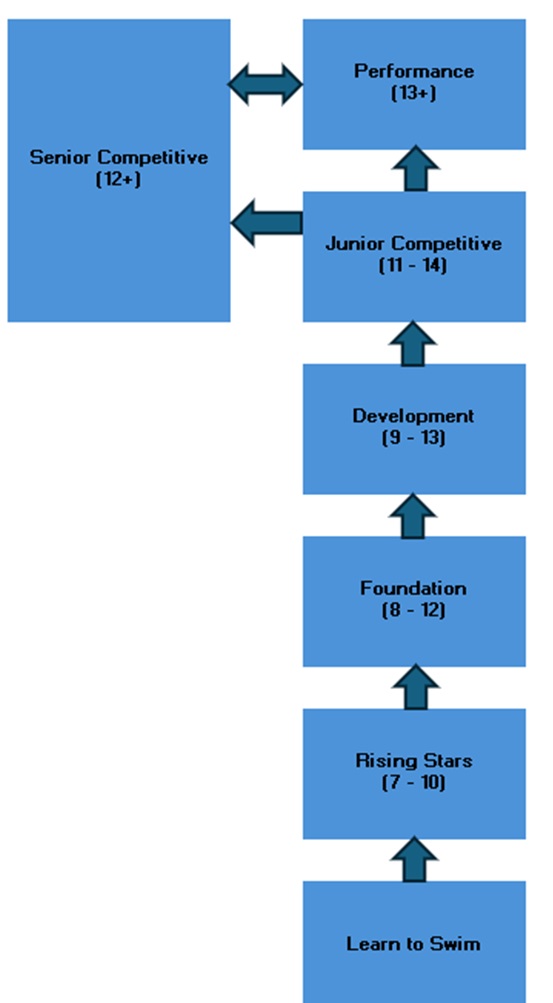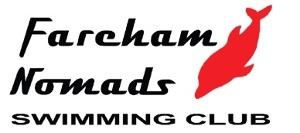Squad Criteria
The setting and introduction of criteria for any squad in any swimming club will always create challenges and cannot and indeed must not be set in stone; there has to be some flexibility for both the swimmers and the coaching staff. A major advantage of having squad criteria is that everyone is aware of what is required to move and progress. Parents and swimmers must be fully aware of squad criteria and, if unable to comply with all aspects of the criteria, should not accept an offer to train with a squad without first discussing with the Squad Coach or Club Coach. Swimmers and parents should also read and adhere to the Club's Code of Conduct. The specific squad criteria for each of our squads can be found below, including information on the essential equipment required at each stage.
 |
Squad |
Age Range |
Competitive Targets |
|---|---|---|---|
| 13+ |
Top swimmers: National qualification |
||
| General: County and Regional qualification |
|||
| Goals: Obtain/maintain Regional and County qualification |
|||
| 12+ |
Top swimmers: Regional qualification |
||
| General: County qualification, Level 3 and 4 meets |
|||
| Goals: Obtain Regional qualification in more than one event, maintain County qualification |
|||
| 11 – 14 |
Top swimmers: Regional qualification |
||
| General: County qualification, Level 3 and 4 meets |
|||
| Goals: County qualification in more than one event |
|||
| 9 – 13 |
Top swimmers: County qualification |
||
| General: Build experience in novice meets and Level 3 and 4 meets |
|||
| Goals: County qualification |
|||
| 7 – 12 |
Top swimmers: Compete in Level 4 open meets |
||
| General: Build experience in novice galas and fun galas |
|||
| Goals: Develop skills and fitness (“build the engine”) |
|||
| 7 – 10 |
General: Build experience in novice galas and fun galas |
||
| Goals: Provide a fun introduction to the world of competitive swimming, develop skills and fitness |
The number of sessions allocated to each squad is determined by what is required to be successful as a competitive swimmer, with 100% attendance being the ideal. The level of minimum attendance maybe different for each squad, as it takes into consideration the different biological/chronological stage of the athletes and also their physiological and psychological development and wellbeing. The intention behind setting a minimum is that it is the required amount of training to progress well through the sport, allowing for illness and occasions when you have other commitments. All swimmers should aim to maximise their attendance at training; failure to do so will prevent swimmers from reaching their full potential, as well as their not being able to cope with the training demands for the squad.
Swimmers are continually monitored as to their overall performance and attendance. If this falls below the expectations of the coaching staff they will be moved to a squad more appropriate to their ability and their commitment to the programme. Such movements are not punishments, but are necessary to ensure that swimmers with the same standards in performance and attendance are grouped together, maximising the opportunities for their progression. Squad criteria are in place as a guide - movement is not guaranteed and the final decision will come down to the professional judgment of the coaching team. The coaching team also reserves the right to move swimmers outside of squad criteria based on their professional judgment.
Becoming a successful swimmer is a long-term process; there has never been and never will be a 10-year-old Olympic swimming champion. As a club and as a coaching team we are dedicated to long-term athlete development (LTAD) and our squad progression is based on, and inline with, British swimming’s recommendations with regards to athlete development support phases (ADSP), which is reflected in the swimmer pathway, squad criteria and coaching practice.
All age group swimmers (14 and under) will train to develop all four recognised strokes and kick ability, as these are the cornerstones to long-term athlete development and successful swimming. Event and stroke specialisation takes place in the senior squads during the transition through youth level swimming (14-16yrs) and into senior level swimming (16yrs+). Swimmers will always show preference towards certain strokes and distances, but this is just a preference and is highly susceptible to change in line with technical development and physical maturation.




